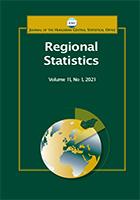Impact of migration and natural reproduction on the development of the Slovak–Hungarian ethnic boundary in eastern Slovakia, 1991–2018
Impact of migration and natural reproduction on the development of the Slovak–Hungarian ethnic boundary in eastern Slovakia, 1991–2018
Author(s): Lóránt Pregi, Ladislav NovotnýSubject(s): Social Sciences, Economy, Geography, Regional studies
Published by: Központi Statisztikai Hivatal
Summary/Abstract: The study evaluates the spatial development of the Slovak–Hungarian ethnic boundary emphasising the role of migration and natural reproduction at the regional and local levels. Using the case study of eastern Slovakia enables assessment development in relatively stable territories and territories where there are intensive changes in the ethnic structure of the population. It also contains remote rural area sand urban areas, including the city of Košice and its dynamically developing suburban zone. Application of statistical methods to the wide range of data sources, their graphic and cartographic visualization show the shrinking of the Hungarian dominant area. The results suggest that the ethnically Hungarian population is declining, especially in municipalities and areas with migration gains and natural decrease of the population with the increasing significance of migration in this development. This has led to the enlargement of the ethnic boundary to the south and the emergence of ethnic enclaves. However, the area with Slovak dominance has not spatially expanded.
Journal: Regional Statistics
- Issue Year: 12/2022
- Issue No: 01
- Page Range: 77-103
- Page Count: 27
- Language: English

